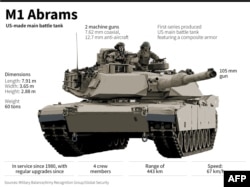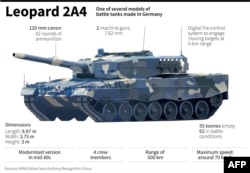Russian forces looking to go on a springtime offensive in Ukraine will be met by more Ukrainian armor and firepower, following an agreement between the United States and Germany to bolster Kyiv’s capabilities with some of the world’s most lethal and coveted tanks.
The U.S. announced Wednesday it will procure and send to Ukraine 31 M1 Abrams tanks, described by American officials as “the best in the world,” enough for Kyiv to field a complete Ukrainian tank battalion.
Washington’s decision, made in recent days, followed weeks of talks with key allies, including Germany, and paved the way for Berlin’s own announcement Wednesday that it will provide Ukraine with 14 of its of its Leopard 2 tanks and open a path for other allies to also send the German-made tanks.
“With spring approaching, Ukrainian forces are working to defend the territory they hold and preparing for additional counter offensives to liberate their land,” President Joe Biden said Wednesday, announcing the decision to send the U.S. tanks to Ukraine 11 months and one day after Russian troops first moved into Ukraine.
“They [Ukraine] need to be able to counter Russia’s evolving tactics and strategy on the battlefield in the very near term,” Biden added during his remarks at the White House. “And they need an enduring capability to deter and defend against Russian aggression over the long term.”
Germany sending tanks
The Leopard 2 tanks from Germany will come directly from German stocks, and they will include ammunition and logistics support. German officials also said training for Ukrainian troops on the tanks will begin soon in Germany.
German Chancellor Olaf Scholz said the decision to send the Leopard 2 tanks to Ukraine was “the result of renewed intense consultations with our allies and international partners.”
“Our goal is to quickly make two tank battalions available together with our allies,” Scholz said. “Germany will always be at the forefront when it’s about supporting Ukraine.”
Ukrainian President Volodymyr Zelenskyy praised the German decision via Twitter, saying he was “sincerely grateful” and that the provision of the Leopard 2 tanks would bolster Kyiv’s efforts to defend itself from Russia’s advances.
Following the German announcement, Poland and Finland said they, too, would provide Ukraine with Leopard 2 tanks. The Netherlands and Spain said they also are open to the possibility.
How quickly Ukraine will be able to incorporate the Leopard 2 tanks into its arsenal and get them on the battlefield remains to be seen. But Ukrainian officials see the German tanks as part of a one-two punch, which will be followed in the coming months with the rollout of a Ukrainian battalion of U.S.-made M1 Abrams tanks.
Ukrainian officials: more help is needed
Even so, some Ukrainian officials say Wednesday’s announcements, while “very cool,” are not enough.
In an interview with VOA, Mykhailo Podolyak, a Zelenskyy adviser, said Kyiv needs a total of about 250-350 tanks from U.S. and European partners.
He also said long-range missiles will be needed to support Ukraine’s growing armored vehicle capabilities.
“Long-range missiles are a pragmatic solution to protect Ukrainian personnel, protect armored vehicles and drastically destroy the firepower of the Russian army,” Podolyak told VOA.
For now, U.S. officials caution that the arrival of the M1 Abrams will take months, though training for Ukrainian troops on how to operate them and additional training for tank maintenance crews will get underway soon outside of Ukraine.
“We will have the ability to put in place a very careful training program but also a very careful program to be able to maintain and sustain these tanks, which do require a good deal, a good deal of assistance,” a senior U.S. administration official told reporters at a Wednesday briefing on the condition of anonymity under ground rules established by the White House.
Additionally, along with the 31 M1 Abrams tanks, the senior administration official said the U.S. would supply Ukraine with eight M88 Hercules Recovery Vehicles—needed to help with tank maintenance—120mm rounds and other ammunition, along with added support vehicles and equipment.
Altogether, the package is worth about $400 million, the Pentagon said Wednesday.
About-face for US
The U.S. decision to provide Ukraine with the M1 Abrams tanks is somewhat of an about-face for some U.S. officials, many of whom had dismissed the idea of sending Abrams tanks to Ukraine. They warned that while Abrams tanks are very capable, they are difficult to maintain and require more fuel than Kyiv can spare.
“We should not be providing the Ukrainians systems they can’t repair, they can’t sustain, and that they, over the long term, can’t afford, because it’s not helpful,” Under Secretary of Defense for Policy Colin Kahl told reporters just last week.
But the Biden administration on Wednesday downplayed such concerns, saying the change in thinking is based on events on the ground.
“One of the things that we’ve been trying to do is [to] do the best we can to evolve the capabilities we are providing to Ukraine with the war itself,” a second senior administration official told reporters.
“We’ve been talking about tanks internally, and we certainly have been talking about tanks externally with allies and partners now for quite some time given what we expect will be the kind of fighting that will occur in the weeks and months ahead,” the official said. “We do expect that Mr. Putin [Russian President Vladimir Putin] and the Russian military will try to go on the offense here in coming weeks and months as the weather gets better.”
Russia: tanks will be ‘destroyed’
Word of the German and U.S. decision to send top-end battle tanks to Ukraine was met with a new round of warning from Russian officials that the decisions would only serve to escalate the conflict.
Anatoly Antonov, Russia’s envoy to the United States, described the pending U.S. decision as “another blatant provocation against Russia” in remarks posted on the embassy’s Facebook page.
“It is obvious that Washington is purposefully trying to inflict a strategic defeat on us,” Antonov said, while vowing the American tanks “without any doubt will be destroyed as all other samples of NATO military equipment.”
Russian government spokesman Dmitry Peskov dismissed the news as “a failed plan” during a telephone press briefing Wednesday. Peskov said the deployments of the U.S. and Germany tanks are an “overestimation” of their potential to help the Ukrainian army, and he predicted the machines “will burn like all the rest.”
Russian Foreign Ministry spokeswoman Maria Zakharova alleged the German decision was more evidence that the West was engaging in a “pre-planned” war against Moscow.
Ongoing consultations
Despite the Russian rhetoric, Western officials said Wednesday talks continue about additional ways to support Ukraine.
The White House said President Biden spoke Wednesday with German Chancellor Scholz, French President Emmanuel Macron, British Prime Minister Rishi Sunak and Italian Prime Minister Giegia Meloni.
Senior U.S. officials said U.S. National Security Adviser Jake Sullivan also was consulting with key allies in meetings that began late Tuesday.
Sunak, who has pledged 14 of his country’s Challenger 2 tanks to Ukraine, welcomed the news from the U.S. and Germany in a post on his official Twitter account earlier Wednesday, calling it “the right decision by NATO allies and friends” which will “strengthen Ukraine’s defensive firepower.”
“Together, we are accelerating our efforts to ensure Ukraine wins this war and secures a lasting peace,” Sunak wrote.
Ukrainian officials have said Western battle tanks, like the Leopard and the Abrams, will allow their forces to maneuver more effectively, with greater firepower and protection, as they seek to push back Russian forces occupying their country.
VOA’s State Department Bureau Chief Nike Ching, VOA’s Senior Diplomatic Correspondent Cindy Saine, VOA’s White House Bureau Chief Patsy Widakuswara, and VOA White House Correspondents Anita Powell and Misha Komadovsky contributed to this report.
Some information for this report came from The Associated Press and Reuters.


